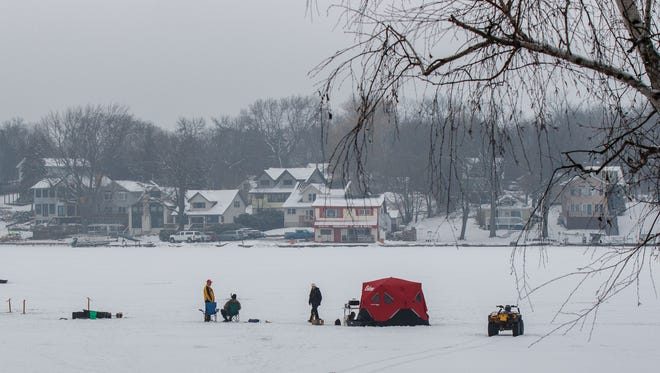Freezing temperatures have made ice on local lakes over eight inches thick, but caution is always advised
 Evan Frank
Evan Frank
The recent drop in temperatures has lured more and more people onto area lakes. But even with temperatures dipping below zero, caution should always be taken.
"There is no such thing as safe ice," said Wisconsin Department of Natural Resources conservation warden supervisor Rick Reed.
Area lakes such as Okauchee, Pewaukee and Fowler have more than 8 inches of thick ice, but Reed cautioned that each lake is different.
"In a lot of the lakes in the area there are springs, there is a little bit of current underneath," Reed said. "There are all kinds of factors that change each individual water body."
A larger lake like Pewaukee will take longer to fully freeze, he added.
"Big water bodies freeze last," Reed said. "When you get to the Pewaukees and the Nagawickas where you have one big center area that is wide open, those haven't even been frozen for a week. I would be really, really extra cautious on those big bodies."
While the DNR, or any other organization for that matter, doesn't officially measure the thickness of the ice, there are sites — such as like www.lake-link.com — where people can share the ice conditions they've encountered on area lakes.
Those sites can be a helpful tool for ice fishermen.
"It's a great hobby," Reed said of ice fishing. "I do it myself. It's just one of those things that really comes down to the individual to make sure they're checking it for themselves so they feel comfortable, regardless of what the depth is."
While caution is taken by many, accidents do happen. In early December, Western Lakes Fire District responded to a dog that fell through Lac La Belle.
The department is staffed with 15 divers and has boats in case it needs to make a rescue. Some of the firefighters are trained in ice water diving, while the entire staff is trained in surface water rescue.
One of the department's boats is a rapid development craft that resembles a banana boat that is 10 feet long. It fills up with air in less than a minute and fits two firefighters.
According to Reed, cars, ATVs, ice shanties and snowmobiles find their way to the bottom of lakes on an annual basis.
"Last year, I think we did really good until the last week," Reed said. "When it warmed up last year it warmed up overnight, so people that have little trailers and ice shanties and stuff like that out there if they weren't paying attention, we had stuff going through everywhere."
If someone or something does go through the ice, the DNR will take action .
"There are regulations that if something goes through the ice, it has to be removed," Reed said. "It can't be just left down there. Typically, we come in at the end of that and make sure the people are taking responsibility for getting out whatever went in."